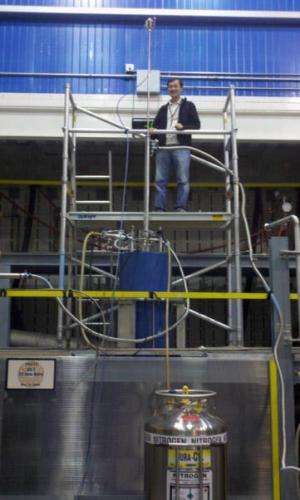MagLab scientists publish trailblazing superconductivity study

(Phys.org) —A pioneering study on superconductivity by MagLab physicist Dragana Popović and collaborators has been published in Nature Physics. It unveils results that shatter long-held beliefs about the effects of magnets on superconductors.
The paper—"Two-stage magnetic-field-tuned superconductor-insulator transition in underdoped La2-xSrxCuO4"—published online May 4, describes a surprising discovery about the destruction of high-temperature superconductivity by strong magnetic fields.
Superconductors are materials that conduct electricity without resistance at very low temperatures—but they are also known to lose that property if the temperature becomes too high or the magnetic field too strong. Knowing precisely how this happens holds the promise of spectacular advances for future technologies.
"We strove to solve a fundamental puzzle underpinning the physics of high-temperature superconductors", said Popović, a Florida State University Distinguished University Scholar and a MagLab senior scientist.
"People still do not really understand what exactly happens in these high-temperature superconducting materials, but to probe their behavior, it is common to apply magnetic fields," she said. "We wanted to take a deep look at the effects of the magnetic fields on superconductors, to learn precisely how the magnetic field destroys the superconductivity in the vicinity of the absolute zero of temperature."
The MagLab experimental group, which also included Xiaoyan Shi, a doctoral student, and Ping Lin, a postdoctoral research associate, conducted a three-year study of unprecedented detail and scope on how the compound of lanthanum, strontium, copper, and oxygen (La2-xSrxCuO4) transitioned from a superconducting state to an insulating one.
"Everyone assumed this transition from superconductor to insulator would be immediate," Popović said. "You start with a superconductor, you apply a high magnetic field to kill it, and right away you obtain an insulator."
But the team discovered something totally unexpected. They observed that magnetic fields reveal not just one phase transition, but two, separating three distinct phases of vortex matter, or quantum current whirls that control the superconducting state.
"What we found, first of all, was striking evidence that quantum physics controls these phase transitions," she said. "And secondly, in contrast to what has been traditionally assumed, we discovered undeniable evidence of an intermediate phase, separating the superconductor from the insulator."
And that is a fundamental new breakthrough in the field of superconductivity. Vladimir Dobrosavljević, a professor in FSU's department of Physics and director of the MagLab Condensed Matter-Theory, who collaborated on the paper, notes: "The results of this experimental study will drive the theorists back to the drawing board: We'll have to re-think the basic many-body physics of quantum vortices."
More information: "Two-stage magnetic-field-tuned superconductor–insulator transition in underdoped La2-xSrxCuO4." Xiaoyan Shi, et al. Nature Physics (2014) DOI: 10.1038/nphys2961. Received 21 August 2013 Accepted 02 April 2014 Published online 04 May 2014
Journal information: Nature Physics
Provided by Florida State University




















